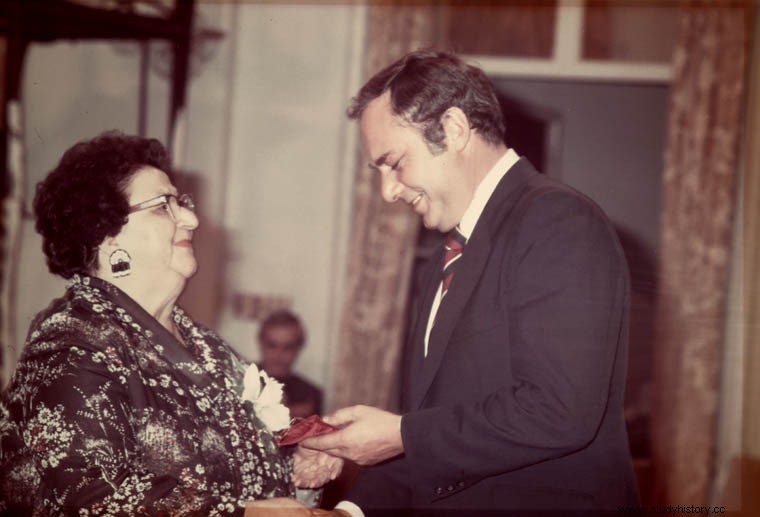Native American of the Kanien’kehá:ka people, Mary Two-Axe Earley (1911 – 1996) advocates for the rights of Indigenous women and children; after decades of struggle, she obtains the repeal of a discriminatory law.
A childhood in reserve

Daughter of Juliet Smith and Dominic Onenhariio, Mary Two-Axe Earley was born on October 4, 1911 on the Kahnawá:ke Indian Reserve, Quebec. His parents are both from the Five Nations Iroquois:his mother is Oneiout and his father Kanien'kehá:ka, a people better known as the Mohawk (an exonym attributed by their enemies, the Algonquins). Mary's parents separated when she was little, and the child lives with her mother, a teacher and nurse, in North Dakota in the United States.
In 1919, Juliet died during the global flu epidemic of 1918, called the Spanish flu, which killed between 50 and 100 million people around the world. Orphaned, Mary then returned to Kahnawá:ke to live with her grandparents. At the age of eighteen, she decided to move to Brooklyn, New York, to look for work. There she meets Edward Earley, an electrician of Irish origin; the two marry soon after and have two children, Mary and Edward.
The Indian Act
According to the Indian Act of 1876, having married a "non-Indian", Mary then lost her status as an "Indian". Resolutely assimilationist, the Indian Act defines who is "Indian" and who is not, and makes this status incompatible with Canadian citizenship. women marrying a “non-Indian” lose their status, while the converse is not true. Very concrete consequence:Mary and her family no longer have the right to live on the reserve. She can no longer participate in politics, vote in elections on the reserve or be buried there.
Mary inherited a family home on the Kahnawá:ke reservation; the law threatens to make him lose it, and the reserve council tries to drive him out. She will describe herself as “a guest in her own home”. Mary actually only manages to keep it because her daughter Rosemary, growing up, marries a Kanien’kehá:ka man from the reservation. She then began to campaign to change the law.
Activist
As early as 1956, Mary Two-Axe Earley campaigned with the Indian Affairs Committee to change the law and in particular its impact on the lives of women. In 1967, she co-founded the organization Indian Rights for Indian Women. , and advocates through speeches and publications. When Prime Minister Lester B. Pearson opened in 1967 – at the request of women's associations – a Royal Commission on the Status of Women in Canada, with a view to investigating the situation of Canadian women and promoting equality, Mary filed a brief.
In January 1970, the commission published 167 recommendations to combat discrimination and improve the status of women, including the amendment of the Indian Act . The recommendation was not followed, neither by the government nor by the future Assembly of First Nations. Mary Two-Axe Earley is not giving up. With other women, she created the Quebec Native Women's Association in 1974. Gradually, she gained political support, particularly from female MPs.
In 1983, a first constitutional conference on the inclusion of the rights of Aboriginal peoples in the Canadian Charter of Rights and Freedoms was held in Ottawa. Quebec Premier René Levesque, won over to her cause, gave her his seat and invited Mary to speak before government and First Nations representatives; she then asks them to free her sisters:"Please search your hearts and minds, follow what your conscience dictates, free my sisters." »
In June 1985, after thirty years of combat, the Canadian government promulgates the Bill C-31 , which amends the Indian Act , puts an end to the situation of discrimination it created and restores status and rights to thousands of women. A week later, Mary becomes the first woman to recover her rights in a ceremony.
Mary Two-Axe Earley died in August 1996, at the age of 84, on the Kahnawá:ke reservation.
